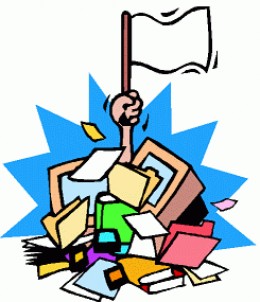 Believe it or not, it only takes a few steps to get your online files organized. Below are seven steps to help you save countless hours and avoid those embarrassing situations that come from searching for lost files. Let’s get started!
Believe it or not, it only takes a few steps to get your online files organized. Below are seven steps to help you save countless hours and avoid those embarrassing situations that come from searching for lost files. Let’s get started!
1. Start at the Root
Determine where you want your file system to live on your computer. Having all your files and documents under one ‘root’ folder on your computer will make it easy to locate your files. Many single Windows users have all their folders, files, and documents stored haphazardly in the ‘Documents’ or ‘My Documents’ folder on their PC. If this sounds like your system, then you might want to consider starting from scratch. The easiest way to do this is to save all your current folders, files, and documents to a new folder and name it something like Archive_2015 or any appropriate name that’s easy to remember. Now you can start to create a new file structure with broad categories without losing any of your current information. After your new filing system is created, you can move previously created files and documents to the newly created system on an as needed basis.
2. Create a File Structure
File structure is the backbone of your filing system and it begins with using folders for general categories. Think big when creating filing categories and limit the number of folders to a critical few. Describe the contents of the folders with short commonly used, meaningful terms. Start broad and get more specific as you add files and documents to those broad category folders.
Examples for business folder names:
Administration
Clients
Financial
Insurance
Legal
Marketing
Organizations
Sales
Vendors
Projects
Examples for personal folder names:
Financial
Medical
Health & Wellness
Housing
Insurance
Taxes
3. Use Sub-Categories
After you have created your folders using broad categories, you will want to create files with sub-categories. Sub-categories are used to organized those files and documents within your folders. You may have a folder called ‘Projects’ and within that folder are several files or sub-categories called Project-A, Project-B and Project–C.
4. Determine a Naming Convention
It’s important to name your folders and files consistently and logically. Storing multiple drafts of the same document can get confusing, and a naming convention is one way to avoid that confusion. Also, adding a date at the end of the file name is a great way to keep track of multiple documents, and the addition of initials at the end of the file name will add clarity if more than one person is working on the same document.
Naming convention examples:
Jane_Doe
Jane_Doe_1/1/15
Jane_Doe_1/1/15_JD
5. ‘Save As’ You Go
File your documents in the proper location by using the ‘Save As’ feature. ‘Save As’ allows you to save and file your documents as you go, so they will be placed in the correct file or folder from the start.
6. Clean Up Your Desk Top
Evaluate what you really use and delete those icons or shortcuts that are outdated or infrequently used. Note: deleting a shortcut is not the same as deleting a file, folder or program from your computer. Deleting the shortcut will simply remove it from your desktop. A program like Fences is a great way to automatically sort out all those remaining icons into organized, easy to see boxes and categories. The program can sort the categories for you or you can create your own categories.
7. Backup Your Files
Have a regiment in place to regularly back up your files. If your hard drive fails or is damaged and your only source of backup is your computer, then you risk losing all of your business transactions and correspondence. The rule of thumb for data protection is “if you need it to run your business, then back it up.” Having all your files saved to a ‘root’ will make that process easy.
“I’m just a paper person!” Do you ever hear or say that when it comes to keeping a calendar, to-do list, or records? I know I have been saying that for years, always preferring to collect my life and thoughts on paper.
The reality is, if we dare open our mind and heart to try something new, there are numerous apps for our phone that will truly make our life so much easier. Yes it does take a small investment of will and time to learn them, but in the end — I promise it is worth it.
To start my own journey in breaking through my paper comfort zone, I investigated the benefits of using a calendar app on my phone, instead of using a paper calendar. Below is my comparison chart showing reasons it might be worth making the switch. If you already embrace the paperless possibilities in today’s world, this may be the perfect article to pass on to a not-yet-tech-savvy friend!
Now it’s up to you to try a calendar app for yourself and move past the paper person persona! Challenge yourself to try it for a week, starting today, and see how it can revolutionize your life!
Everyone has a different threshold for what it takes to go from manageable to maniacally crazed. In honor of National Clean Out Your Computer Day, celebrated the second Monday in February, I offer advice on four hot spots for digital clutter:
My advice: focus your efforts on one of the four electronic clutter hot spots OR do a little purging in each category to get yourself calm and collected — literally.
When you approach winnowing your documents, photos, desktop or email, get ready for a trip down memory lane. You will be reminded of things you’ve completely forgotten — and some should remain forever forgotten, but some should be resurrected…or completed. It’s helpful to have a notepad next to you to jot down the name of a particular file that you want to compare to others and select the best version. You may want to start a to-do list for future decluttering projects. Clearing out your computer can get addictive…
EMAIL: Without getting into specifics about which apps work best on which platforms, the principles of email management are consistent:
YOUR DESKTOP: Go for Zen on your desktop and completely clear it! Apart from straining your computer to refresh icons continually, desktops are there to provide the calm visual space your brain craves while processing data. While your desktop may seem like an infinite holding basket for what’s important at the moment, or a safe place to store what might get lost, left unchecked it will become a graveyard of expired photos, files, and reminders. A final caution: desktop items are typically not included in routine back-ups.
PHOTO MANAGEMENT: When there is no monetary cost involved in taking photos there is little motivation to weed out bad shots and duplicates: except photos take up a LOT of memory. So rather than pay for upgrades, take a look at your stockpile of digital pics and decide on your keepers. Trash the rest. Do not attempt to manage your photos in a day; a few hours a week is a good goal until you have controlled your collection to date, and then a half-hour a week to maintain going forward. If that seems too daunting…just deal with the photos from January 1, 2015 and tackle your larger collection with a pro.
DOCUMENTS: The two biggest categories to tackle are:
YOU have to decide what maintenance schedule will work for your lifestyle…but National Clean Out Your Computer Day aside, once a year is not enough.

As the holidays approach, ASK before you make a single purchase:
Where will it “live”? This is probably the last question people ask… but it should be first! If you don’t want to invite clutter, make sure you know where something will be stored when not in use; otherwise, it will sit out, collect dust, and get in your way.
Why do I need this? If you’re purchasing a gift… do they really need it? Would they appreciate tickets to an event more than an object to clutter their home? Recent studies have shown that experiences give us longer-lasting JOY than material items.
Can I afford it right now? This is not just a monetary question… electronic purchases require an investment in time to set up; new phones beg for back-ups before you transfer over to a new device and don’t forget about learning curves!
What would happen if I waited? Shopping can be fun. I am the first to admit that it’s neat to re-envision your table set for the holidays, or a seasonal lift to your bedroom (I am a sucker for linens!), but your brain doesn’t know the difference between the fantasy of seeing your table set and the reality of seeing your bed made with cozy soft colorful sheets that say autumn. Go ahead and put it in your cart (be it physical or electronic)… just don’t hit “confirm purchase.” Resist placing that order. Do NOT hand over your credit card.
If you KNOW you need it, and you can afford it, but you really haven’t a clue where to put it, hire a professional organizer to help! We’re terrific at thinking outside the box, or cabinet, or fridge, or pantry, or laundry room, or bedside table or linen closet… Our list goes on for fabulous solutions to your everyday challenges.
As the holidays approach, try keeping a list of these shopping questions in your wallet or taped to your computer screen to help avoid unnecessary purchases. List the where’s and why’s in an order that makes sense to you and your purchasing patterns. This year, go into the holidays feeling in control of your spending, your space, and your holiday experiences. Your budget and your loved ones will thank you!
 Every email that comes in is an opportunity. Every Facebook article is a worthwhile read. Every free 60 page ebook is a life saver. But come on now, if you read everything you could read you would NEVER BE DONE and on top of that YOU WOULD NEVER GET TO WHAT IS MOST IMPORTANT.
Every email that comes in is an opportunity. Every Facebook article is a worthwhile read. Every free 60 page ebook is a life saver. But come on now, if you read everything you could read you would NEVER BE DONE and on top of that YOU WOULD NEVER GET TO WHAT IS MOST IMPORTANT.
I’ve been a long-time advocate for short and sweet, so I always try to keep everything I share manageable and digestible in 5 minutes or less. That’s what I can do for you.
What can you do for yourself?
If you choose to spend your time on things that just pop up and come your way you will NEVER get to the work you want to do. To be a high performer be clear on what is important and spend your time on what matters. All the rest? JUST SAY NO – LET THEM GO.
 Happy New Year and Happy National Get Organized Month! I always set a few goals for myself and my business each New Year and organizing certainly plays a key role in accomplishing those goals. Over the years clients have asked for my assistance for many different reasons including New Year’s resolutions.
Happy New Year and Happy National Get Organized Month! I always set a few goals for myself and my business each New Year and organizing certainly plays a key role in accomplishing those goals. Over the years clients have asked for my assistance for many different reasons including New Year’s resolutions.
On the other hand, those resolutions are often derailed because “life happens.” Whether you are ready or not, you could lose your job, suffer through an illness, or deal with a divorce. You can’t always be prepared for the ups and downs of life, but being organized can help. Here are my ten organization basics to help you handle the uncertainties of life and achieve those pesky resolutions you are so adamant in keeping. Let’s break it down:
If it takes less than 60 seconds, do it! Whether it’s putting bills away, making a quick phone call, adding a number to your phone, sending a quick email, do it! Take seconds now or hours later.
A home for everything. Finding a home means you know where to put it when it gets misplaced and when you need it — it’s there!
Choose a time management tool. Use a day planner or smartphone to keep track of appointments, tasks lists, self-appointments, and vacation plans.
Keep lists. Use your time management tool for all lists: clothing, household items, food, gifts, etc. Keep sizes and dimensions on the list. Lists save time and money and no more buying things twice (you aren’t the only one).
Consolidate contact information. Gather mailing addresses, emails, and phone numbers and place them in your time management tool. No more little pieces of paper and sticky notes all over the place.
Convenience is the key. No digging and no searching. Place things where you use them; keep most-used items front and center — no pushing other things aside to get to what you need.
Focus! Small and large task completion requires focus. Break down any large task into smaller, manageable pieces and stay focused: one bite at a time.
Know what to eliminate. Surround yourself with tasks, events, and people who support your goals. Eliminate the rest and learn to say “no” (I have a handout on my website).
Consult the experts. Don’t reinvent the wheel; ask friends for recommendations and referrals; consult the Internet (but don’t believe everything you read); and then trust your judgment.
Maintenance! Things will get out of order (even in my home), so do a little each evening or once a week in order to keep it that way. Have respect for yourself, your time, and your home. Every time you put something away, it’s a gift to yourself.
Whether you are making resolutions are just trying to smooth out life’s bumps in the road, get organized! You’ll be glad you did.
Clutter Quote: “God takes care of the breath of your life; it is your responsibility to take care of the depth of your life.” Unknown